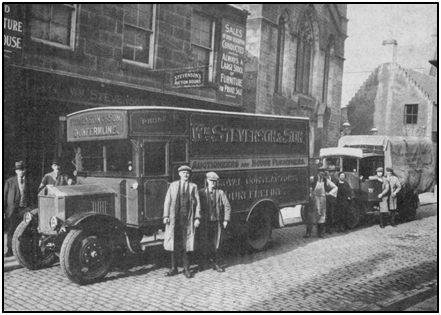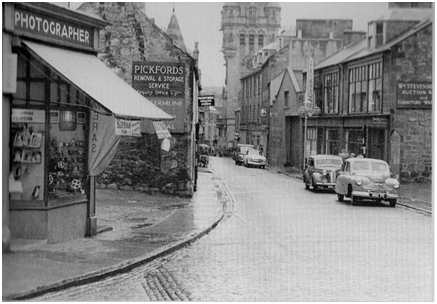House Furnishers, Auctioneers & Removal Experts
by George Beattie
William Stevenson was born in 1856 at Martyr’s Place, Dunfermline, the son of a local linen warper. On leaving school he served an apprenticeship as a power loom mechanic in one of the Dunfermline Linen Factories. In the 1881 census William, then a 24 year old power loom mechanic, and his wife Mary, are residing at South Inglis Street, Dunfermline.
He moved to Alloa where he set up in business as fruiterer, a venture he remained in for a number of years until he returned to Dunfermline around 1900 where he set up as an auctioneer (Note 1). It is thought that Mr Stevenson perhaps began this career whilst still in Alloa. In the 1901 census William and his family are back in Dunfermline, residing at 32 Hill Street, with his occupation given as auctioneer/fruiterer. In the 1910/11 Dunfermline Trade Directory, William’s auctioneering business address is 30 Bruce Street. A Stevenson Auction advert of 1910 indicates that at that time his auction sales were conducted in the Drill Hall, Bruce Street and that he also conducted sales of livestock at ‘Dunfermline Market Stance’.

This Dunfermline business soon expanded and around 1920 old properties on the west side of Bruce Street were bought by Mr Stevenson and new shops, showrooms and an auction room were built. In addition to the retail side of the business, the auction section mainly specialised in second-hand furniture but soon became an all-encompassing auction room with sales each Tuesday. Mr Stevenson, and his son Ian, must have conducted the auctions with some panache, as they became a regular haunt for middle-aged woman who would bring flasks of tea and sandwiches with them whilst they watched the auction take place.

When the Royal Naval Base was established at Rosyth during the First World War, Mr Stevenson soon realised that the regular movement of naval personnel between the naval ports in the south of England and the rapidly developing Garden City at Rosyth meant there was money to be made in the furniture removal business. This soon became another branch of the Stevenson business. The development of the Abbey View local authority housing estate in the town in the 1950 and 60’s also provided Messrs Stevenson with a great deal of removal business.
The three strands of the business – furniture sales, removals and auction room – all complimented each other well and created a very healthy business. Carpet fitting was added to the business during the 1950 or 60s, when carpets began replacing linoleum as the favoured floor-covering. William Stevenson died in August, 1933, by which time his son, Ian, was well qualified to take over the reins of the business.

Richard Innes, from Cowdenbeath, who joined Stevenson from school in 1958, recalled that Ian Stevenson was in charge of the general office with Miss Biggar and two female clerks. The furniture and carpet showroom was run by Mrs Clark and Mrs Wallace. Mr Howie was by then the auctioneer. The basement of the building formed an upholstery and carpet fitting workshop for Jimmy Moyes and Davie Butchart. An adjoining area in the basement was used by two seamstresses, Mrs Bowie and Mrs Arnott. A pram shop, containing everything necessary for new born babies, was located in a building on the opposite side of Bruce Street from the main Stevenson showroom and run by Mrs Morris. A full-time cleaner, Mrs Erskine, was also employed. The garage for Stevenson’s three removal/delivery vans was located behind the main showroom with a very narrow entrance which regularly caused hold-ups on Bruce Street as the drivers made reversing manoeuvres on the narrow street.

The foreman driver was Jack Graham who did most of the long-distance work. Richard said that Jack Graham was an expert at using every square inch of loading space on his vehicle when conducting house-hold removals. Richard also said that nearly all Stevenson’s staff appeared to have been long-term employees. Stevenson also had storage units for customers’ furniture, one of which was in Stewart, the builder’s yard in Phoenix Lane and another in St Margaret’s Street. Ian Stevenson went into semi-retirement during the early 1960’s and his son-in-law, John Reid, became manager when the business became a limited company. In 1972, the Stevenson business was bought over by Dykes of Glasgow, and the following year near neighbours W & D McKissock was also bought over by Dykes and both shops amalgamated (Note 2).
In addition to running the Bruce Street concern after his father’s death, Ian Stevenson also found the time to be Chairman of Dunfermline Ice Rink Ltd. and was a member of the Board of Directors of Lawsons of Dyce, one of the largest food processing firms in the country, having its origins in Dunfermline. At various times he was also a manager and trustee of Dunfermline Trustee Savings Bank.

Note 1 – Advert in 100 years of D’ine Press of 1959 avers that Stevenson had used advertising space in the Press for 60 years, placing the firm’s probable arrival in Dunfermline at 1899.
Note 2 – See Bygone Dunfermline of November, 1992, re Stevensons/McKissock.
